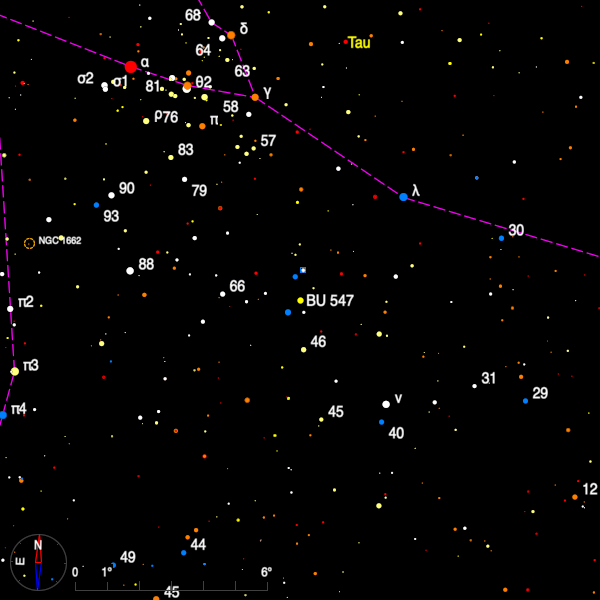December 2022 - Double Star of the Month
47 Tauri = BU 547 (04 13 56.39 +09 15 50) could be be described as a typical Burnham discovery. The stars are both unequal and close, a type of visual binary that Burnham seemed particularly adept at finding.
The V magnitudes are 5.1 and 7.3 and at present they are 1".3 apart in position angle 339 degrees. They have moved slowly apart since discovery and seem likely to continue this trend for some years to come.

Hipparcos determined a parallax of 9.83 mas for the whole system whilst Gaia DR3 contains only the results for the primary star. This comes in at 7.96 mas.
I was able to measure the pair on 2 nights in 1993 using the 8-inch Cooke refractor at Cambridge Observatories, but it was not an easy object. 47 Tau is about 8 degrees south-west of Aldebaran and sits in a low power field with magnitude 4.3 mu Tau. A good 6-inch should show the stars which have been allocated a preliminary orbit of 479 years.
The Washington Double Star (WDS) catalogue also lists an unassociated field star of magnitude 13 which is at 228 degrees and 28".
SKF 949 (03 53 33.33 -46 53 37.2) came to the attention of Brian Skiff at Lowell Observatory whilst examining stars in Nancy Houk's spectral type reclassification project in order to add to his extensive collection of spectral types.

Examination of Vizier showed a common proper motion companion, V = 8.5 and spectral type G, some 76" distant from the K2III primary which has V = 6.1. and which is almost due south of its companion. Gaia DR3 confirms that the stars have similar parallaxes, indicating that they are 359 light-years distant.
This is an easy pair for the small telescope and may even be visible in a pair of suitable binoculars. The system is in a unremarkable area of Horologium, about 6 degrees south-west of alpha.
Bob Argyle - Double Star Section Director